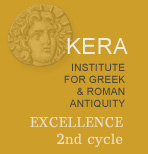Main Site . Dikmen Tepe/Boubon
5 10 |
ΥΣΚ[- - - - -] μαίου [- - - -] ΔΟΥΚ[- - - -Ἀρ-] τεμέου [- - -] αλβίου α[- - -] Μανέου [- - Οσ-?] βάρου ορ̣[- - -Πια-] τηραβίο[υ- - -] καὶ AN[- - - -] ΞΕΝΙ[- - - - -] ΤΩ[- - - - - -] Ω[- - - - - -] |
Left part of a stone block, found and documented by Bean and Schindler in 1966 among the ruins of the theater in Boubon. Only the left edge of the stone was preserved, and all other sides were broken.
Height: 35 cm; length: 7 cm; depth: 15 cm; letters 0.7-1 cm.
Schindler 1972, no. 38 (pl. 3.16: photograph of squeeze); Milner 1998, p. 3, no. 1.37.
L. 3-4 : On Ἀρτεμέου as the genitive of the male name Ἀρτέμης; cf. i.a. TAM II 174 l. Db 13 (Sidyma, Lycia); 748 (Nisa, Lycia); JHS 8 (1887), p. 256, no. 41 (Pogla, Pisidia).
L. 5 : This ending can belong to the hellenized forms of the Latin names Σάλβιος (i.a. IK Keramos 44a and 45; Cormak, ABSA 59 [1964], p. 24, no. 29 and p. 27, no. 41, Aphrodisias, Caria), Ἄλβιος (i.a. IK Ephesos 74, l. 66; 974, l. 23; 975, l. 2), Κάλβιος (Anatolian Studies 17 [1967], p. 115, no. 37, Pisidian Antioch) or possibly to Οξαλβιος, attested once in Oinoanda (BCH 24 [1900], p. 341, no. 4; Zgusta 1964, no. 1094.5).
L. 6 : Μάνης (Zgusta 1964, no. 858.1) is a common name in Pisidia. Cf. IK Kibyra I 269. A genitive Μανέους is attested in TAM III 727 and 841 (both from Termessos) and in no. 6.
L. 6-7 : ΒΑΡΟΥ might belong to the genitive of the name Οσβαρας, attested in Termessos (TAM III 20; 98; 107; 199; 212; 547; 629; 692; 776; cf. Zgusta 1964, no. 1120.1). Ονοβαρας is another possibility, attested in the territory of Cibyra and Oinoanda (Heberdey and Kalinka 1897, p. 7, no. 20, no. 21; p. 54, no. 79). In addition, the Hellenistic allotment list from Balboura mentions a [Μο]υοβαρας and an Ομοβάρας (Hall and Coulton 1990, p. 132).
L. 8 : The name Πιατηράβιος or Πιατηράβις (Zgusta 1964, no. 1251.2) is attested many times in Pisidian Termessos; TAM III 4, ll. 3-4; 24, ll. 22-25; 61; 62; 132; 152; 176; 199; 206 etc.
L. 10-12 : The photograph of the squeeze provided by Schindler (pl. 3.16) does not include the remains of these lines.
We have not been able to locate this stone. To judge from the photograph of the squeeze provided by Schindler though, and by the size of the letters as indicated by him, the lettering was similar to that of nos. 1 and 2, so that this piece is most likely of Hellenistic date too.

